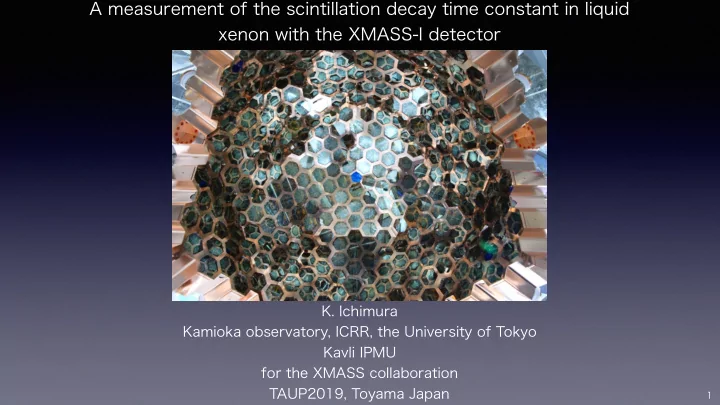

A measurement of the scintillation decay time constant in liquid xenon with the XMASS-I detector K. Ichimura Kamioka observatory, ICRR, the University of Tokyo Kavli IPMU for the XMASS collaboration TAUP2019, Toyama Japan 1
Motivation : Scintillation Process of LXe discrimination. calibration source in XMASS-I 192) and NR (JINST 13 (2018) P12032) using scintillation decay time of ER (NIM A 834 (2016) time depend on the ionization density. and emit light. 20ns) (τ~30 ns) 2 • 2 scintillation process in LXe : • Direct excitation and electron-ion recombination • Both lead to the formation of excited dimers, Xe 2 * • Two state : singlet (τ s : a few ns) and triplet (τ T : ~ • Fast component fraction (F s ) and recombination • Such information can be used for the pulse shape • We have conducted the measurement of the
XMASS-I detector ~832kg LXe in Kamioka Mine ~80cm 642 PMTs Water Tank Detector Surface PMT-R10789 3 3 • Single phase liquid Xenon detector (~832kg LXe in an active volume) • Successfully data taking until Feb. 2019 • 642 low BG PMTs (Hamamatsu R10789, NIM A 922 (2019) 171) • each PMT signal is recorded by waveform digitizers (CAEN V1751) • 10m x 10.5 m water tank with 72 20 inch PMTs for muon veto
4 Decay time constants of Electron recoil NIM A 834 (2016) 192
Internal Calibration setup can be removed 5m etc.) used for analysis. evaluation of the scintillation decay time constant N.Y.Kim et al, NIM A784, (2015) 499 Top PMT Valve Gate motor Stepping 5 • Inner calibration : 55 Fe, 109 Cd, 241 Am, 57 Co and 137 Cs • 55 Fe, 241 Am and 57 Co source were used for the • Frequent calibration ( 57 Co) to monitor • Photo-electron (PE) yield • optical parameter (Absorption, Scattering length
[ns] <latexit sha1_base64="qm19cfrIlBoEWUqXUwVN8ZXNuw=">ACqHichVHPT9RQEP4oirgqrHJQ46WR8EM3u5lXiIKJCZGLxwVcFgJk09a3WOm2TdvdZG36D/gPePAEiTHEP8OLN7iYuF68ajxi4sUD01cMIQSYpm9mvplv3vfeswLXiWKiXp/Wf+nywJXBq4Vr128MDRdv3lqO/HZoy5rtu364YpmRdB1P1mInduVKEqzZbmybm3NZ/V6R4aR43sv4m4gN1rmpuc0HduMGWoU51cbyet0YkLXn+rzdC0E5EmYjqdNLpcKBtpWXmRlhWQpyWRlRaMtIHhUKjOEqVWRKzj4R+OhAVUjY6N/Nj/b3n3erfvEj1vESPmy0YKEh5hjFyYi/tYgQAgY20DCWMiRo+oSKQrMbXOX5A6T0S1eNzlbO0I9zrOZkWLbvIvLf8hMHWP0lXbpgL7QJ/pF/86clagZmZYueyvnyqAx/PbO0t8LWS32MV4ds87VHKOJGaXVYe2BQrJT2Dm/8+bdwdKTxbFknHboN+vfph595hN4nT/2hwW5+B7ZA/y/Zf3sYNmoiKmKscAv8Qy5DeIe7mOS7/sx5vAcVdR4313s4Rt62kOtqtW1bxV6zvijOCEadYhpI2ldQ=</latexit> <latexit sha1_base64="jrlxSTjog5zN/jOef+O7xBFy7QE=">ACoHicSyrIySwuMTC4ycjEzMLKxs7BycXNw8vHLyAoFacX1qUnBqanJ+TXxSRlFicmpOZlxpaklmSkxpRUJSamJuUkxqelO0Mkg8vSy0qzszPCympLEiNzU1Mz8tMy0xOLAEKxQtYR8ZXZ9WqKyjYKsSkFSUmVxvWVhsa1WpUAoV1jWp1LcAMw1ptMEPbsFYXTBvVanJxQsoG+hZGhamhkqYDIM9QzAQNnB4v4F8VsvJAPyBZYzxDCkMOQzJDOUMuQypDLkMZQA2TkMiQzFQBjNYMhgwFAFItlqAaKFQFZmWD5VIZaBi6g3lKgqlSgikSgaDaQTAfyoqGieUA+yMxisO5koC05QFwE1KnAoGpw1WClwWeDEwarDV4a/MFpVjXYDJBbKoF0EkRvakE8f5dE8HeCunKBdAlDBkIXjeXMKQxWIDdmgl0ewFYBOSLZIj+sqrpn4OtglSr1QwWGbwGun+hwU2Dw0Af5JV9SV4amBo0mwEUAbBQVsDNCDPSMzTWMwoExoQTAwRwMEgzKDFoAMPbnMGBwYMhgCEUaO9ChuMFxguMikxeTD5MwVClDIxQvUIM6ApigAZ7uibw=</latexit> <latexit sha1_base64="hg2yXKGw1HVW5PaJ/f5TYEgwUHI=">ACrHicSyrIySwuMTC4ycjEzMLKxs7BycXNw8vHLyAoFacX1qUnBqanJ+TXxSRlFicmpOZlxpaklmSkxpRUJSamJuUkxqelO0Mkg8vSy0qzszPCympLEiNzU1Mz8tMy0xOLAEKxQu4R8ZXZ9UqKNgqxKQVJSZXG9ZWG5vWaugaVwLFdY1qtQ2NwCxDIMscxIKJaBvWQhRpG9VqcnHFCygb6FkaGFqaGSpgMgz1DMBA2cHi/gXxWy8kA/IFljPEMKQw5DMkM5Qy5DKkMuQxlADZOQyJDMVAGM1gyGDAUAUi2WoBoVAVmZYPlUhloGLqDeUqCqVKCKRKBoNpBMB/KioaJ5QD7IzGKw7mSgLTlAXATUqcCganDVYKXBZ4MTBqsNXhr8wWlWNdgMkFsqgXQSRG9qQTx/l0Twd4K6coF0CUMGQhdeN5cwpDFYgN2aCXR7AVgE5ItkiP6yqumfg62CVKvVDBYZvAa6f6HBTYPDQB/klX1JXhqYGjSbARQBsFBWwM0IM9IzNYzCgTGhBMDBHAwSDMoMWgAw9ucwYHBgyGAIRo71qGywx3GO4y6TGFMEUzxUKUMjFC9QgzoACmNABLS6Z5</latexit> 3rd derivative 6 1st derivative [ADC] [ns] [ns] 2nd derivative Savitzky-Golay filter(1st,2nd,3rd derivative) is used. (1PMT, 1 event) Decay time constant of electron recoil Raw waveform To obtain the pulse timing, peak search algorithm based on <latexit sha1_base64="7zs0ubjd4MCN5qXulv2nY7G6ub0=">ACo3icSyrIySwuMTC4ycjEzMLKxs7BycXNw8vHLyAoFacX1qUnBqanJ+TXxSRlFicmpOZlxpaklmSkxpRUJSamJuUkxqelO0Mkg8vSy0qzszPCympLEiNzU1Mz8tMy0xOLAEKxQvYRcZXZ9Wq6srKNgqxKQVJSZXG9ZWGxrVauhWAmV0jWq1jcAMw1pdMEPbsFYbTBvVanJxQsoG+hZGhamhkqYDIM9QzAQNnB4v4F8VsvJAPyBZYzxDCkMOQzJDOUMuQypDLkMZQA2TkMiQzFQBjNYMhgwFAFItlqAaKFQFZmWD5VIZaBi6g3lKgqlSgikSgaDaQTAfyoqGieUA+yMxisO5koC05QFwE1KnAoGpw1WClwWeDEwarDV4a/MFpVjXYDJBbKoF0EkRvakE8f5dE8HeCunKBdAlDBkIXjeXMKQxWIDdmgl0ewFYBOSLZIj+sqrpn4OtglSr1QwWGbwGun+hwU2Dw0Af5JV9SV4amBo0mwEUAbBQVsDNCDPSMzTWMwoExoQTAwRwMEgzKDFoAMPbnMGBwYMhgCEUaO8ShlMlxmuMKkyeTMFMYVAlDIxQvUIM6AplgA1Wi+g=</latexit> Smoothing reconstructed pulse timing distributions over all PMTs of data peak timing and simulated samples with various timing parameters The decay time constant is evaluated by comparing the Y j = 1 35( − 3 y j − 2 + 12 y j − 1 + 17 y j + 12 y j +1 − 3 y j +2 ) j = 1 Y � 12( y j � 2 − 8 y j � 1 + 8 y j +1 − y j +2 ) j = 1 Y �� 14(2 y j � 2 − y j � 1 − 2 y j − y j +1 + 2 y j +2 ) = 1 Y ��� 12( − y j � 2 + 2 y j � 1 − 2 y j +1 + y j +2 ) j
waveform Find the best F 1 ,τ 2 <latexit sha1_base64="ITvB+hv9IzA3J1q2ZuYsITKN+Lo=">AC3XichVHPTxQxFH4zoOAisOLFhEsjwWCMmzdrokBiQuSAFw2wLpAwMOmU7tIwvzLT3YjHL0YwpWDJ02MUf8MLvwDHLh4Nx4x8eLBNzNrjJrV17R9/fp9r19bN/JUohHPDHNg8MLFoeFLlZHLo2Pj1SsTa0nYiYVsitAL4w2XJ9JTgWxqpT25EcWS+64n1929xXx/vSvjRIXBE70fyS2ftwPVUoJrgpzqU1vsqu20nrH7zE46vpOqzG7FXKQzj7dTO/bZDtc8y2F2m/WgR4slYGvly4Q1buYFsvRPwa0+9ILtVKewNofW3F2L/Z1YNSxiamGJfbCd5+3lsPoObNiBEAR0wAcJAWjKPeCQUNsECxAiwrYgJSymTBX7EjKokLZDLEkMTugejW1abfbQgNZ5zaRQCzrFox6TksE0nuJ7PMcT/Iif8XvfWmlRI/eyT7NbamXkjL+81vj2X5VPs4bdX6p/etbQgtnCqyLvUYHktxClvs6Lwxvzqd3sA3+IX8v8YzPKYbBN2v4u2KXH0FfqAn6/M+idr9Zp1p1ZfoZ94AGUMwyRchxl673uwA9hGZp07idj0Bg1xkzHfGEemIcl1TR6mqvwW5hHPwB2Nrnx</latexit> T scinti follows : <latexit sha1_base64="TbgNotY0CW83nuw3TLMST1coyJ8=">AC1nichVHLSuRAFL0dx1ePj9bZCLMpFKVFbG5a8THg4Iwg4spXa4MtTVJWazCdxKS60Qk9u2FgVrNzMSsFEfED5gPc+AMifoK4VHCj4E2iqPi6IVWnzrn1q0q3TENTyKexpSqD9U1tX18Y8NjU3NiZbWec8uVxkuG3ablbXPGEalshIQ5oi67hCK+qmWNDXxgJ9oSxcz7CtObnpiKWitmIZBYNrkqh8Yr2QlN1shOUKrsb98byvVip+TmqlEIkNJ9kbSfIR3d3DkhHL1F72xJQmNceXbcle8gZqPtGBqWFUhwdU9hyoKQyjY/TreP/W/2+TU3ZiD3KwDZwKERBFgCZugUfIqiA4BC3BD5xLiEj1AVUIE7eEmUJytCIXaNxhVaLd6xF6CmF7o57WLS75KTQSce4z5e4BEe4Blev1rLD2sEvWzSrEde4eSb/7TNXr3rKtIsYfXB9WbPEgowFPZqUO9OyASn4JG/GPrYvbLTKfhTt4Tv1v4yke0gms8iXfnRYz/yBOD3B/y+x1MJ9OqX2p9DS9xHeIog4+Qzsk6b4HYRQmYAoytO8J3MRqYrVKVvmp/FJ+R6lK7M7zCZ6E8vcWVYa3rw=</latexit> 7 In simulation : <latexit sha1_base64="Zcsa+iG7Alb3pWJuYAkuYzOXc=">ACnHicSyrIySwuMTC4ycjEzMLKxs7BycXNw8vHLyAoFacX1qUnBqanJ+TXxSRlFicmpOZlxpaklmSkxpRUJSamJuUkxqelO0Mkg8vSy0qzszPCympLEiNzU1Mz8tMy0xOLAEKxQuYhyjYKpTEV7umpBbUKmiDmMXJmXklmVBOiL8bjBUCZaTmpCbXxgsoG+hZGhamhkqYDIM9QzAQNlB5eu2w2Xc3wLyBZYzxDCkMOQzJDOUMuQypDLkMZQA2TkMiQzFQBjNYMhgwFAFItlqAaKFQFZmWD5VIZaBi6g3lKgqlSgikSgaDaQTAfyoqGieUA+yMxisO5koC05QFwE1KnAoGpw1WClwWeDEwarDV4a/MFpVjXYDJBbKoF0EkRvakE8f5dE8HeCunKBdAlDBkIXjeXMKQxWIDdmgl0ewFYBOSLZIj+sqrpn4OtglSr1QwWGbwGun+hwU2Dw0Af5JV9SV4amBo0m4ELGAGwUFbAzQgz0jM01jMKBMaEwMEcDBIMygxaAD25zBgcGDIYAhFGjvXIbDGcYzjLJMbkweTP5QpQyMUL1CDOgAKYwAD/ogs=</latexit> τ 1 = 2.2±0.3 ns (J. Raun, J. Phys. C 11 (1978) 2645.) for each calib. source Top figure shows 57 Co, Z=0, 1PMT The decay time constant is evaluated by Decay time constant of electron recoil Raw waveform parameters reconstructed WF Detected peak comparing the reconstructed pulse timing simulated samples with various timing distributions over all PMTs of data and T = t Edep + t scinti + t T OF + t T T + t elec ) + (1 − F 1 f ( t ) = F 1 exp ( − t ) · exp ( − t ) τ 1 τ 1 τ 2 τ 2 ( N data − N MC × S ) 2 χ 2 = � i i N data + N MC × S 2 i i i
8 Decay time constant of electron recoil So without F 1 (fast component fraction), MC cannot reproduce the timing distribution around 3 ~ 20 nsec.
9 Decay time constant of electron recoil By converting γ(X)-ray energy into electron energy, above figure is obtained. The obtained data almost reproduced previously reported results and extended them to the lower energy region relevant to direct dark matter searches. 55 Fe 5.9 keV 57 Co 122 keV 241 Am 17.8 keV, 59.5 keV, W X-ray of 59.3 keV
10 Decay time constants of Nuclear recoil JINST 13 (2018) P12032
External Calibration setup detector response to vacuum chamber to the outer Fasten the hose pages. LXe. nuclear recoil events in Fish tape 1/2 inch yield monitor photo-electron 11 • external calibration : 60 Co • easy data taking to • Neutron calibration 252 Cf • To understand the • Details are in the following
neutron calibration setup 12 Inside the water tank XMASS detector neutron calibration pipe Plastic Scintillator (BC400) PMT R580 2 52 Cf source was used for the calibration ( 252 Cf undergoes a spontaneous fission and emits neutrons and gammas)
252 Cf calibration data/MC the timing information evaluation of the scintillation decay time of NR γ related events n related events • offset is adjusted by γ related events timing 13 Data : 1.5 hrs data taking, MC : Geant4 base XMASS MC • PE distribution • Timing distribution (Below 500 PEs) • ( 30 < ⊿T < 100 ns in the left figure) • ID trigger timing - Plastic Scintillator trigger timing • 10 < PEs < 100 events were used for the • This PE range corresponds to : • neutron related events can be collected by using • 1.5 < E < 8.3 keV ee • 6.3 < E < 40 keV nr
Recommend
More recommend